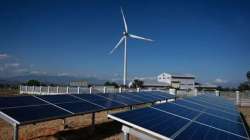India likely to witness 'world's biggest rise' in energy demand this decade: IEA report
Energy demand: While efforts to increase the use of renewable energy will result in it providing up to 60% of the additional demand for power, coal will provide a third of the overall energy demand by 2030.

Energy demand: The International Energy Agency (IEA) claimed that India is anticipated to witness the "world's biggest rise" in energy demand this decade, with demand growing by 3% annually as a result of urbanisation and industrialization. This was stated by IEA in its World Energy Outlook which was released on Thursday.
While efforts to increase the use of renewable energy will result in it providing up to 60% of the additional demand for power, coal will provide a third of the overall energy demand by 2030. Meanwhile, another quarter will be met by oil.
"India becomes the world's most populous country by 2025 and, combined with the twin forces of urbanisation and industrialisation, this underpins rapid growth in energy demand, which rises by more than 3% per year in the Stated Policies Scenario (STEPS) from 2021 to 2030. It sees the largest increase in energy demand of any country," IEA said.
Even if India continues to make enormous achievements with the deployment of renewable energy sources and efficiency regulations, the sheer scope of its expansion means that over the next 20 years, the cumulative import bill for fossil fuels will treble, with oil making up the vast majority of that total.
Russia's invasion of Ukraine led to the first global energy crisis: IEA
According to the IEA, The first global energy crisis has been brought on by ongoing Russia's invasion of Ukraine. "Pressures in markets predated Russia's invasion of Ukraine, but Russia's actions have turned a rapid economic recovery from the pandemic -- which strained all manner of global supply chains, including energy -- into full-blown energy turmoil," it remarked.
Notably, Russia has long been the world's greatest exporter of fossil fuels, but its restrictions on the delivery of natural gas to Europe and European restrictions on the importation of Russian oil and coal are cutting off one of the major routes for international energy trade.
All fuel markets are impacted, but gas markets are the focal point since Russia wants to gain leverage by making consumers pay more for their energy and face supply problems.
In India, coal meets a third of growth with demand rising above 770 million tonnes of coal equivalent (Mtce) by 2030, and continuing thereafter before peaking in the early 2030s.
Oil demand meets a further quarter of the energy demand growth and rises to nearly 7 million barrels per day by 2030 from 4.7 million bpd in 2021.
Coal generation likey to continue expanding
Coal generation is projected to continue to expand in absolute terms, peaking around 2030, though its share of electricity generation likely to fall from just below 75 per cent to 55 per cent over this period.
Renewables meet more than 60 per cent of the growth in demand for power, and account for 35 per cent of the electricity mix by 2030 -- solar PV alone accounts for more than 15 per cent.
"However, coal still meets a third of overall energy demand growth by 2030, and oil, mainly for transport, another quarter," IEA said.
In India, coal meets a third of growth with demand rising above 770 million tonnes of coal equivalent (Mtce) by 2030, and continuing thereafter before peaking in the early 2030s.
Oil demand meets a further quarter of the energy demand growth and rises to nearly 7 million barrels per day by 2030 from 4.
7 million bpd in 2021.
In the Announced Pledges Scenario (APS), more rapid progress in deploying low-emission alternatives in power, industry and transport sectors in particular puts India on a trajectory in line with its goal of net zero emissions by 2070.
In absolute terms, coal generation is expected to keep growing and reach a high around 2030, although during this time, its share of energy generation would decline from just under 75% to 55%.
Renewables will account for 35% of all electricity by 2030
By 2030, renewables will supply 35% of all electricity, meeting more than 60% of the increase in demand for energy. Meanwhile, Solar PV alone will make up more than 15% of this mix.
IEA projected India's oil demand to rise from 4.7 million barrels per day (bpd) in 2021 to 6.7 million bpd by 2030 and 7.4 million bpd by 2040 in STEPS.
Under APS, the demand is projected to rise to 5.9 million bpd in 2030 before falling to 5.4 million bpd in 2040 and further to 3.9 million bpd in 2050.
(With PTI inputs)
Also Read: India set to replace Russia as world’s third largest oil refiner by 2020: IEA

